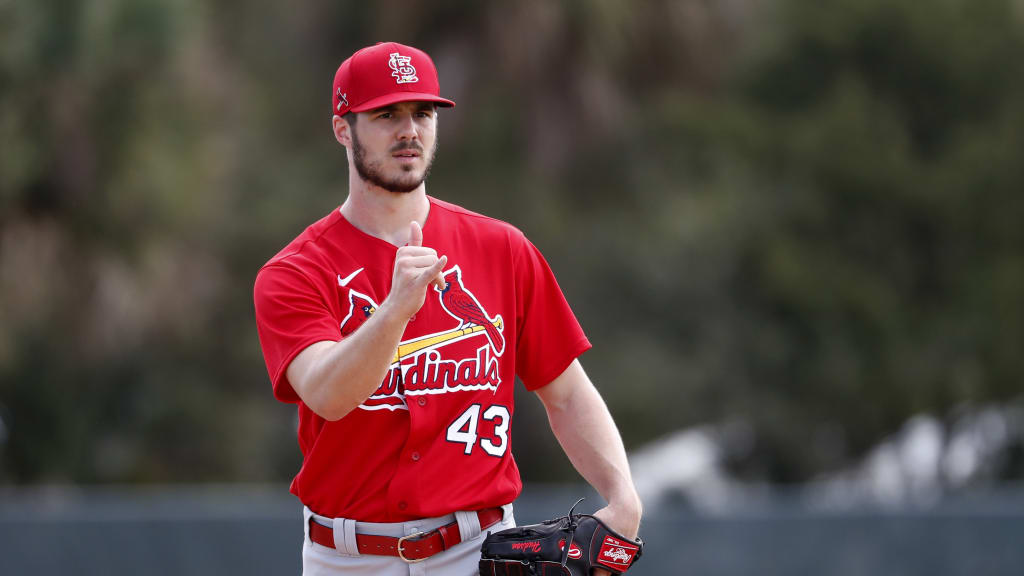
JUPITER, Fla. -- Two things stood out about Dakota Hudson’s 2019 season.
First was that he had a solid rookie season. The 25-year-old right-hander broke into the rotation and stayed there, becoming a constant source of steady production for the Cardinals. His 3.35 ERA was third lowest among rookie starters, and his 16 wins led all rookie starters. That led to a fifth-place finish in the National League Rookie of the Year Award voting.
On the other end of the spectrum was Hudson’s walks -- all 86 of them, which was the most in baseball. He had a 1.408 WHIP and a 4.93 FIP. Hudson relies on his sinker and is one of the best ground-ball pitchers in the game, so he’s not going to have a high strikeout rate. But his walk rate -- 4.4 walks per nine innings -- at times called his command into question.
“When you think about sustainability at the big league level, there are some things that you have to see happen,” president of baseball operations John Mozeliak said. “And for him, when you’re looking at walk rate, strikeout rate, if those are getting too close, and you look at the history of pitching, that’s not sustainable. Ultimately, I hope there’s a change in that trajectory. We have a lot of confidence there can be.”
Hudson is equipped to change that trajectory. He’s started with his mechanics.
Hudson moved to Kansas City this offseason and began working out at Premier Baseball with pitching instructor Bob Zimmermann. Zimmermann is a St. Louis native -- he graduated from De Smet Jesuit High School and went to Missouri State before being drafted by Anaheim in 2003 -- and spent some time pitching in the Cardinals' farm system.
Their focus was to make Hudson’s delivery smoother. He found that he was barring his arm while beginning his delivery -- straightening his arm out as he reached back instead of staying in a fluid motion. Commanding pitches is typically dependent on a repeatable delivery, and this small movement, along with the slight pause that accompanied it, affected Hudson’s pitches.
“I think that’s why I was struggling to find the zone at times, to where you’re going to walk guys, obviously, but having command and control of the zone is a different story,” Hudson said. “I just think it was harder for me to find a consistent feel for every pitch. My stuff had to be perfect for me to be on, almost.”
Hudson’s awareness of his need to improve will help him actually do so in 2020. In his first full season, the learning curve was quick. He spoke about adjusting on the fly many times in '19, and in the final two months of the season, he lowered his WHIP from 1.633 in July to 1.118 in August and 1.222 in September.
“I felt like I got to the point in the season where I was like, ‘OK, things are obviously not going as well -- I’m not operating and moving as smoothly as I would like to,’” Hudson said. “But I always felt good to get out there and compete. It was more of a mental like, ‘Let’s get through this, let’s dominate today and with what I have’ more so than things have to be perfect. I think that allowed me to build and make adjustments quicker, if anything.”
Another factor to what Hudson was seeing in his delivery was the longer season he had. Sometimes the length of the season can alter a delivery’s repeatability. But from the two official bullpen sessions Hudson has had this spring, manager Mike Shildt has seen the fluid motion that Hudson is striving to repeat. The Cardinals will need his stability in the rotation again.
“I think he feels more connected,” Shildt said. “He doesn’t have a violent delivery at all, but he wanted to create a little more compactness to it, a little more repeatability to it, a little simpler.”
Anne Rogers covers the Royals for MLB.com.




